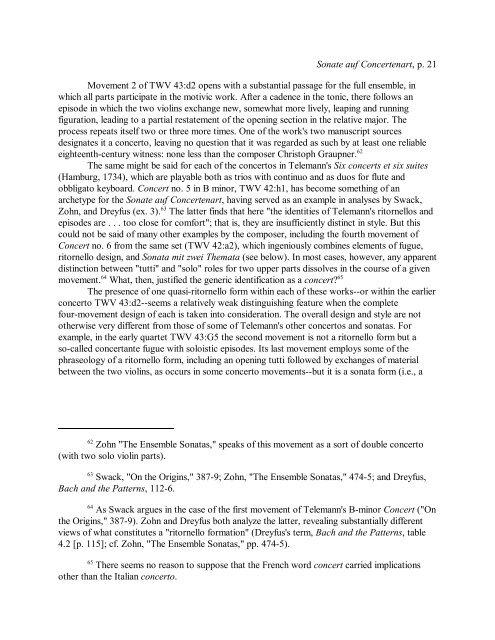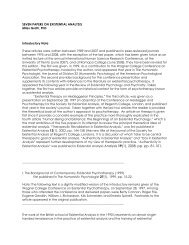The Sonate auf Concertenart: A Postmodern Invention? David ...
The Sonate auf Concertenart: A Postmodern Invention? David ...
The Sonate auf Concertenart: A Postmodern Invention? David ...
Create successful ePaper yourself
Turn your PDF publications into a flip-book with our unique Google optimized e-Paper software.
<strong>Sonate</strong> <strong>auf</strong> <strong>Concertenart</strong>, p. 21<br />
Movement 2 of TWV 43:d2 opens with a substantial passage for the full ensemble, in<br />
which all parts participate in the motivic work. After a cadence in the tonic, there follows an<br />
episode in which the two violins exchange new, somewhat more lively, leaping and running<br />
figuration, leading to a partial restatement of the opening section in the relative major. <strong>The</strong><br />
process repeats itself two or three more times. One of the work's two manuscript sources<br />
designates it a concerto, leaving no question that it was regarded as such by at least one reliable<br />
eighteenth-century witness: none less than the composer Christoph Graupner. 62<br />
<strong>The</strong> same might be said for each of the concertos in Telemann's Six concerts et six suites<br />
(Hamburg, 1734), which are playable both as trios with continuo and as duos for flute and<br />
obbligato keyboard. Concert no. 5 in B minor, TWV 42:h1, has become something of an<br />
archetype for the <strong>Sonate</strong> <strong>auf</strong> <strong>Concertenart</strong>, having served as an example in analyses by Swack,<br />
63<br />
Zohn, and Dreyfus (ex. 3). <strong>The</strong> latter finds that here "the identities of Telemann's ritornellos and<br />
episodes are . . . too close for comfort"; that is, they are insufficiently distinct in style. But this<br />
could not be said of many other examples by the composer, including the fourth movement of<br />
Concert no. 6 from the same set (TWV 42:a2), which ingeniously combines elements of fugue,<br />
ritornello design, and Sonata mit zwei <strong>The</strong>mata (see below). In most cases, however, any apparent<br />
distinction between "tutti" and "solo" roles for two upper parts dissolves in the course of a given<br />
movement. What, then, justified the generic identification as a concert?<br />
64 65<br />
<strong>The</strong> presence of one quasi-ritornello form within each of these works--or within the earlier<br />
concerto TWV 43:d2--seems a relatively weak distinguishing feature when the complete<br />
four-movement design of each is taken into consideration. <strong>The</strong> overall design and style are not<br />
otherwise very different from those of some of Telemann's other concertos and sonatas. For<br />
example, in the early quartet TWV 43:G5 the second movement is not a ritornello form but a<br />
so-called concertante fugue with soloistic episodes. Its last movement employs some of the<br />
phraseology of a ritornello form, including an opening tutti followed by exchanges of material<br />
between the two violins, as occurs in some concerto movements--but it is a sonata form (i.e., a<br />
62<br />
Zohn "<strong>The</strong> Ensemble Sonatas," speaks of this movement as a sort of double concerto<br />
(with two solo violin parts).<br />
63<br />
Swack, "On the Origins," 387-9; Zohn, "<strong>The</strong> Ensemble Sonatas," 474-5; and Dreyfus,<br />
Bach and the Patterns, 112-6.<br />
64<br />
As Swack argues in the case of the first movement of Telemann's B-minor Concert ("On<br />
the Origins," 387-9). Zohn and Dreyfus both analyze the latter, revealing substantially different<br />
views of what constitutes a "ritornello formation" (Dreyfus's term, Bach and the Patterns, table<br />
4.2 [p. 115]; cf. Zohn, "<strong>The</strong> Ensemble Sonatas," pp. 474-5).<br />
65 <strong>The</strong>re seems no reason to suppose that the French word concert carried implications<br />
other than the Italian concerto.















